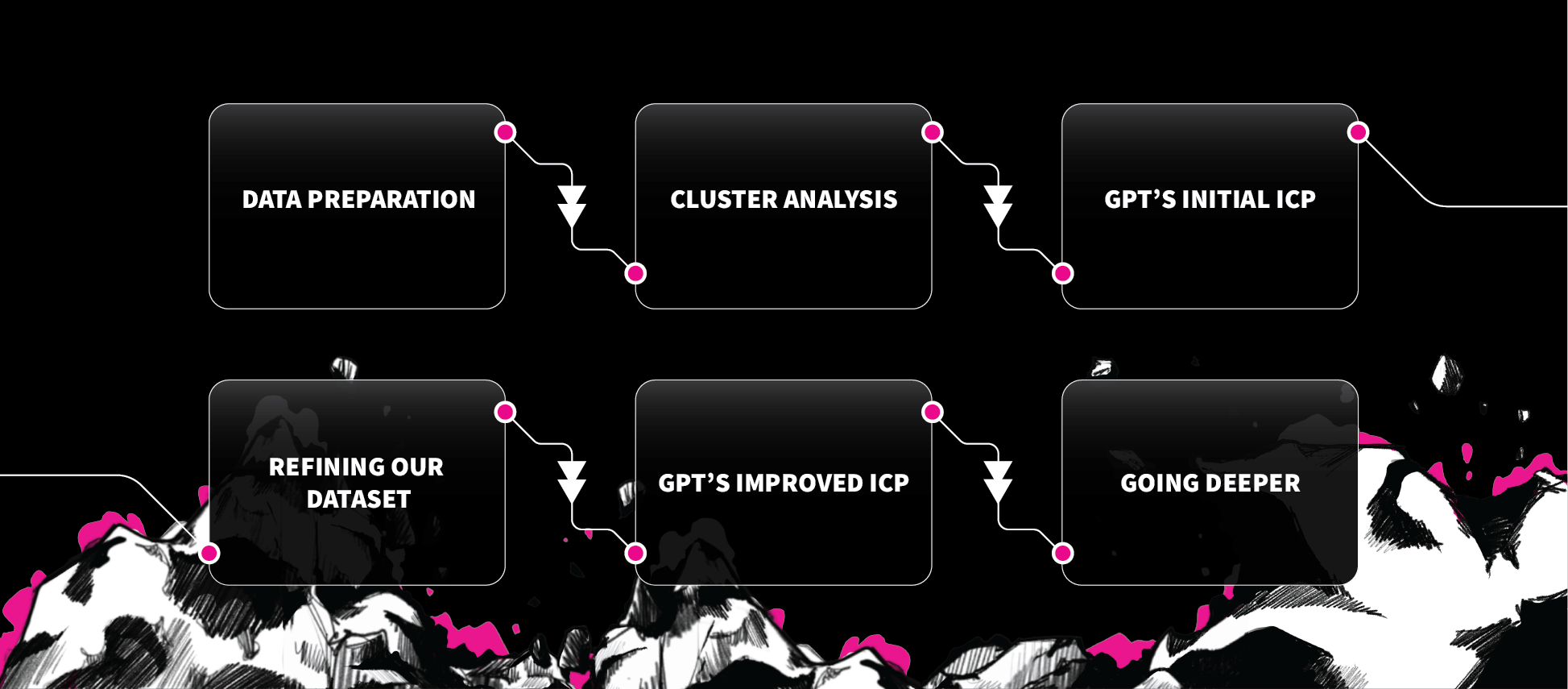Defining Your True ICP With GPT from Revenue Pulse on Vimeo.
TL;DR In our first AI experiment, our team used GPT analysis to determine our Ideal Customer Profile (ICP). Our process involved data preparation, cluster analysis and refining the dataset using a genetic algorithm. This experiment was a significant step forward, enabling us to determine an organization’s true ICP within just a few hours of work. Exciting possibilities lie ahead!
A couple of weeks ago, one of my colleagues said to me, “I really believe that within 3-5 years, we’ll be able to analyze Salesforce data and determine the true ICP of an organization”.
My immediate thought to this was: why wait?
With the AI tools available at our disposal, we can do this now.
“Determine the true ICP of
an organization within a few hours.”
So I put a small team together, and we started working on a way to achieve this – and frankly, the results were pretty incredible. After 3 days of work, we came up with a process centered around GPT analysis that can determine the true ICP of an organization within a few hours.
Here’s how we did it.




Step 1: Data Preparation
The first thing we did was ask ChatGPT directly how to approach this project. Essentially, it told us we needed to run a cluster analysis on a CRM data export using a Python script (this is the simplified version of the response).
With that in mind, we went into Salesforce and exported the last 2 years of our company data. For privacy and confidentiality reasons, we anonymized the data by deleting some information like client names and project values, then replaced those fields with unique identifiers and profitability approximations.
Step 2: Cluster Analysis
After that, we ran our data through a cluster model using a Python script we created. After some testing and tweaking, we were left with 4 cluster groups based on 3 company variables we chose: profit, frequency of purchases, and number of employees. This cluster analysis in and of itself is far from revolutionary – but the next step is where things started to get very interesting.
Step 3: GPT’s Initial ICP
We took our 4 cluster groups and asked GPT to give us a description of each – and it did. It was able to pull from its enormous knowledge base to give relatively accurate, complete descriptions of each group. Then, we fed GPT a short definition of our company profile and asked it to define our ICP based on the cluster group that best fit. The results were interesting, but it wasn’t exactly what we were looking for. How could we refine things further?
Step 4: Refining Our Dataset
We decided to use a genetic algorithm whereby ChatGPT would generate a list of companies that fit the chosen cluster, then regenerate the list but keep the top 3 companies and drop the worst 2 companies. After doing this 25 times, we were left with a highly refined list of 27 companies that matched the chosen cluster group.
It gave us information about
revenue, growth profiles and marketing priorities.
Step 5: GPT’s Improved ICP
Now, using this new list of 27 companies, we asked ChatGPT once again to generate an ICP for us. And this time, the results were amazing. It gave us extensive information about revenue, growth profiles, industry, location, marketing priorities, primary tech, and business models. Astoundingly, it also summarized all of it beautifully for us.
Step 6: Going Deeper
In pursuit of the best results possible, we took things a step further by giving GPT more information about who we are as a company and where our strengths lie as an organization – allowing it to refine our ICP even further based on that.
We also asked GPT questions about our ICP, such as: Who are the decision-makers at this company? What are their pain points relative to their positions?
And it gave us great material to work with, highlighting general ICP pain points as driving growth in revenue, optimizing and improving marketing and sales efforts, keeping up with industry trends, and ensuring seamless integration of technology and security. Wrapping it all up by asserting that if we focus on solutions to these pain points, we can demonstrate value to decision-makers.
Data Privacy and Safety
As a final note, I think it’s important to emphasize that there is no data privacy or security risk involved with this process either. The core Salesforce dataset we used was not only anonymized, but it was never actually touched by the GPT engine; The data itself was only used in our internal cluster analysis before we fed these clusters – which are essentially just groups of companies based on characteristics – into GPT.


The irony of all this is that when we look at the list of companies GPT defined as our ICP, many of them are already our clients. But it also gave us a list of companies we need to start a conversation with, which is highly valuable for any business.
Overall, this first experiment has been an excellent step forward. Having a process that can utilize GPT analysis to determine the true ICP of an organization within just a few hours of work is incredible output.
Stay tuned for what’s next.
P.S. In case you missed it, you can read our post about the essential skills of the AI economy.


